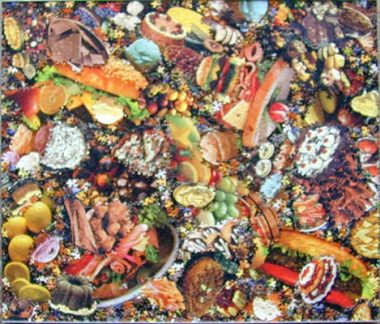By Susie Kalil
 Al Souza’s extravagant “paintings” are so visually disruptive they demand to be stared at long and hard—that is, if you can manage to fix your gaze on them at all. Stand before these works, composed of thousands of layered jigsaw-puzzle pieces, loose and in semi-completed chunks, and the whole immediate environment seems in flux; the paintings appear to slide back and forth, creating a vaguely feverish sensation. The eye darts from quaint New England barns, breezy tropical palms, and huge slices of cheese-oozing pizza to Victorian playing cards, rainbow popsicles, Troll dolls, Ukrainian eggs, and swathes of candy corn. (Souza’s imagery depends largely on chance: He buys the puzzles in thrift shops and garage sales and uses the completed sections that were returned to the box intact by the previous owner.) The paintings’ peculiar interminglings evoke Surrealism and appropriation, Abstract Expressionism and Pop. But no matter how dense the layers, the accumulation never reads as reckless or unordered.
Al Souza’s extravagant “paintings” are so visually disruptive they demand to be stared at long and hard—that is, if you can manage to fix your gaze on them at all. Stand before these works, composed of thousands of layered jigsaw-puzzle pieces, loose and in semi-completed chunks, and the whole immediate environment seems in flux; the paintings appear to slide back and forth, creating a vaguely feverish sensation. The eye darts from quaint New England barns, breezy tropical palms, and huge slices of cheese-oozing pizza to Victorian playing cards, rainbow popsicles, Troll dolls, Ukrainian eggs, and swathes of candy corn. (Souza’s imagery depends largely on chance: He buys the puzzles in thrift shops and garage sales and uses the completed sections that were returned to the box intact by the previous owner.) The paintings’ peculiar interminglings evoke Surrealism and appropriation, Abstract Expressionism and Pop. But no matter how dense the layers, the accumulation never reads as reckless or unordered.
Focusing on how the eye moves across a painting’s surface, Souza examines the poetics of the mind in operation. His obsessiveness is awesome. More than 100,000 puzzle pieces went into The Peaceful Kingdom, 1998, the sprawling eighteen-foot-long extravaganza that dazzled viewers at the Whitney Biennial last year. The trippy, labor-intensive spirit of this tour de force enhanced the feeling that its space enveloped you; there was no single best place to enter the work and, likewise, no convenient place to leave it. By contrast, the recent paintings arc modest in size. Concentrating more on subtleties of color and space than on spectacular visual devices, Souza aims to establish cleverly dissonant juxtapositions that are jarring yet strangely seductive. Each work moves in exciting rhythms, with the colorful fragments punctuating the larger composition.
Looking at Field & Stream, 2001, from a distance, you see golden fall foliage, orchids and tulips, snowy mountain peaks and raging rivers, all holding their own where no hold seems possible. At the same time, the quirky colors chartreuse, magenta, celadon—set up an array of visual pops; the illusory space between flowers and fields becomes a lush, vibrating zone. Up close, the painting sucks you into a vortex of energy. In Yum Yum, 2001, the eve careens across Belgian waffles and scoops of ice cream only to crash-land on platters of dell meats. Lemon slices tumble over greasy French fries and chocolate bonbons, bump up against candy liars, and convene with gooey slabs of strawberry shortcake. Souza gives equal pictorial weight to each image, but since some appear as if seen from above and others from the side, some are upside down, most are tilted, and each has a different light source, the eye jumps not only from image to image but also swoops from beside to above to behind to below in a series of visual and spatial shifts and collisions. ‘Nuf Said, 2001, also examines the human capacity for gorging on stuff. Cutesy baby dolls, Dole pineapple cans, faux jewels, rubber ducks, marbles, LifeSavers, firecrackers, fishing lures, yellow roses, Chiclet packages, Mr. Peanut clocks, spools of thread, and more are tossed side by side, end to end, one on top of the other. The scanning gaze is encouraged by the reappearance of the same images in entirely different strata. The panning’s cultural references whir so fast, and the visual field buzzes so intensely, that the puzzle pieces seem about to lie shaken loose from the support.
Culling from a discarded world of excess, Souza recombines ideas and images. His knack for balancing order and chaos and the irrepressible wit that emanates from his paintings create a happily disjunctive union of art’s lofty aspirations and the low charms of boxed pastimes.
